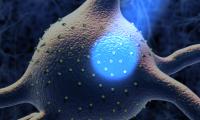The world’s largest brain research prize is Danish! And we will soon be announcing this year’s winners

The neurotransmitter dopamine motivates us to act – sometimes sensibly but sometimes decidedly unwisely. In the run-up to the announcement of the winners of the 2018 Brain Prize on 6 March, one of last year’s winners – Professor Wolfram Schultz – tells us about his ground-breaking research into the brain’s reward system, dopamine and addiction.
The brain’s reward system is powerful – so powerful that it sometimes seems to force people down a road that can only lead to negative experiences. And Professor Wolfram Schultz – Professor of Neuroscience at the University of Cambridge in the UK – points out that you just need to look at smoking if you want an example of this.
“Between 1900 and 1999 – so, over the course of the last century – around 100 million people died from smoking worldwide. That’s more than the number of people who died in wars during the same period,” says the professor, who regularly lectures at Danish universities.
Wolfram Schultz received The Brain Prize in 2017 together with two of his colleagues, Peter Dayan and Ray Dolan – both affiliates of University College London (UCL). The Brain Prize is the world’s largest brain research prize, and it is accompanied by a monetary award of € 1 million. It was established by the Lundbeck Foundation and has been awarded every year since 2011.
The winners of the 2018 Brain Prize for outstanding brain research will be revealed on 6 March when the Danish Society for Neuroscience holds its annual meeting. The prize itself will be presented by HRH Crown Prince Frederik on 9 May.
The three scientists who shared the prize in 2017 received it for their significant contribution to our understanding of the dynamics of the complex system that links learning to the human brain’s reward system.
This system involves specific brain cells which react to the neurotransmitter and reward chemical dopamine – and, in animal studies, Wolfram Schultz discovered these reward signals in dopamine neurons in the brains of mammals.
“I never gamble”
In humans, the influence of dopamine on learning is crucially important to motivation – and, as a result, to our actions.
However, the system can become out of sync, resulting in unfortunate behaviour which is governed neither by common sense nor by rational thought and which is not in our own best interests. In other words, the result is addiction, whether this be gambling, alcoholism, drug addiction or nicotine addiction.
The link between dopamine and inappropriate addictive behaviour is certainly not easy to explain. And the link has not yet been fully scientifically explored.
Put simplistically, as Professor Wolfram Schultz says, the brain becomes ‘overstimulated’ by dopamine in cases of addiction. By contrast, when people are positively motivated by dopamine, they strive to learn.
If we could track the individual neurons in the brain, down to the minutest detail, while they are using dopamine either to stimulate positive learning or to help maintain a pattern of abuse, we would find answers to many of the questions about brain health and behaviour.
Wolfram Schultz says that one of the addiction-related issues which would be interesting to investigate more closely is gambling. He recently held a lecture for around 100 students and teachers at the University of Copenhagen:
“Why are some people more addicted to gambling than others? In the case of gambling or other types of so-called financial risk-taking, people have different profiles. I saw this very clearly in Puerto Rico, a place I’ve visited several times. People gamble here – you can often place a bet as soon as you enter the hotel lobby – and I’ve noticed that some people seem to hang around for days. Others – and I belong to this group – are more or less immune to gambling. I find gambling uninteresting, and I never gamble.”
On/off switches
One of the technologies that may give us a better understanding of addiction is optogenetics. Brain researchers have spent around 20 years developing and refining this technique, which was awarded The Brain Prize in 2013. It was shared by six scientists.
Optogenetics is all about controlling the activity of manipulated brain cells using light emitted at specific wavelengths, and scientists are working on switching the neurons on and off in the brains of animals. This allows the scientists to track the processes in the brain, helping them to understand degenerative diseases such as Alzheimer’s and Parkinson’s and to study phenomena such as pain and various types of addiction.
Neurons are injected with a light-sensitive on/off molecule before the scientists place the cells in the regions they wish to examine in the brains of the laboratory animals. And this on/off feature is activated using a light source in the form of a small antenna in the animal’s brain.
In the long term, we may also be able to use optogenetics to study the role of dopamine in learning and addiction-related processes in the human brain, while the brain is actually working.
But before we reach this point – and this may be many years from now – numerous tests must be performed on animals. And Wolfram Schultz points out that we will need to refine many technical aspects of optogenetics because we cannot simply insert manipulated brain cells and optical devices into human brains:
“When we work with optogenetics in animal studies today, for example in mice, we insert the manipulated cells to be studied into specific locations in the brain. If we are to apply optogenetics to people, we will need to develop non-invasive methods to inject these neurons into the patient’s blood stream and not insert them surgically, as we do in animals today.”
However, the first thing to do is to develop safe cell types for the purpose – and that is a lengthy process. Furthermore, manipulated cells suitable for humans must also be able to pass the blood-brain barrier, which separates the brain tissue from the blood.
Another challenge we face if we are going to conduct optogenetic studies of living human brains in the future is the issue of the light source. How do we produce the light that will activate the on/off molecules in the manipulated neurons without needing to insert a small antenna into the person’s brain?
“Science has actually already advanced in this area,” says Wolfram Schultz. And he mentions a study by the Massachusetts Institute of Technology (MIT).
Scientists at MIT have constructed a molecule – an on/off switch – which is so sensitive to light that it can be activated by an external light source pointing at the skull.
The molecule can be activated by light that penetrates the cranial wall, and tests on mice have proven that the method works. This shows that it is not absolutely necessary to place the optogenetic light source in the actual brain.
The study was headed by Professor Ed Boyden of MIT, who, as it happens, is one of the six scientists who received The Brain Prize in 2013.
Click on the link to watch a TED Talk by Ed Boyden if you are interested in further details about the potential of optogenetics.


